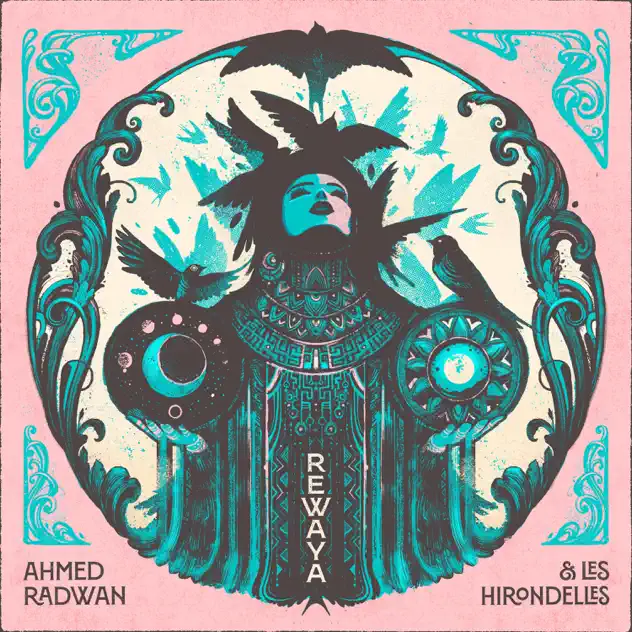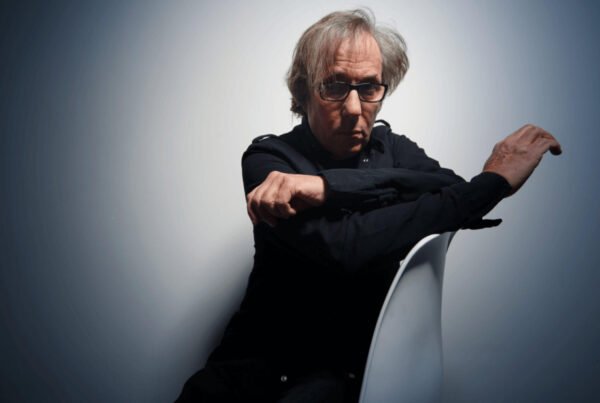Every year my local commune (essentially our local city council) in Luxembourg puts on the Blues’n’Jazz Rallye, a free jazz festival for anyone and everyone to attend in the city’s old quarters. Surprisingly, for a free festival held in the city’s parks and a select number of bars, the event is well-attended by concert-goers and big name musical acts. It’s great, minus some grumpy people who complain there isn’t enough blues and jazz. Can’t win ’em all over I guess.
Of course, a local festival of this kind features plenty of local acts to fill out the roster, one of which is actually jazz! Enter Ahmed Radwan & Les Hirondelles, a self-described oriental jazz fusion band based out of Luxembourg. Bringing together traditional jazz instrumentation and Oriental harmonies created on the traditional Middle Eastern instrument oud, Ahmed has sought to develop a project that focuses on the freedom to express oneself through cultural exchange.
Ahmed Radwan & Les Hirondelles released their debut album, Rewaya last year after a residency at a studio in Luxembourg allowed them the time and flexibility to fully explore the sounds that Ahmed had in his head. I sat down with Ahmed and Hy-Khang Dang, saxophonist for Les Hirondelles, to discuss their musical journeys, exploring musical signatures from different cultures, and working in a jazz group.
‘Hy-Khang is now the best at actually interpreting Arabic scales,’ Ahmed tells me, grinning with pride. ‘He’s so into it now. He is actually one of the best to get the tonality and integrate it in his playing, which is why it is so unique and special.’ The two musicians, while having very different backgrounds, have just settled into the couch of a small café we agreed to sit in to carry out the interview.
The groups debut album, Rewaya, which translates to ‘stories‘ or ‘novel‘, is a love letter to both jazz and Middle Eastern sounds. The music paints scenes of hazy, sleepy streets in Cairo, as well as smokey, dark lounges on rainy nights. Each musician is their own distinct patch of a musical quilt while Radwan’s oud is the distinct thread that holds it all together.
‘I think about Arabic music and all these scales and I get excited,’ responds Hy-Khang, ‘I was like, how do you do it? Which note is the one that doesn’t sound like our scale? And then I try to incorporate it.’
Having met each other initially through BELONG (an arts project aimed at bringing together the multicultural communities through cultural art, dance and music), the two have developed a close relationship and a shared musical language through jazz expression. Hy-Khang goes on to explain a bit more about BELONG and the sharing of music through classes, saying:
‘We as musicians who attend these seminars and shows, we learn from each other. We end up playing in the concerts ourselves but we play it with all of our own instruments. So we end up playing Indian music with the oud and saxophone. It’s nice because it sort of shows how all these instruments and music, not music genres, but music from different places can sound within the same group.’
This is where the initial foundation for what would become Les Hirondelles was first set. Ahmed, upon moving to Luxembourg to complete his Master’s degree, was introduced to the project through his friend, and creator of BELONG, Adham Al-Sayyad. ‘When I got here I started investing all my time in music again with Adham and in his project. It was, and is, a good hub to meet many musicians and make connections. At the same time I had this idea that I wanted to do the Sahab project that I had in Cairo.’
Sahab, Ahmed’s first foray into creating his own songs, was a oriental fusion project where he played the oud, an instrument he is self-taught in. Learning the oud was a way of being able to write his own compositions. Talking about his background, he explains that while the oud is his main focus and way of expressing himself, his first love was the violin.
‘I started a bit late. There was one teacher passing by the classes randomly with a violin that didn’t even work. I remember I just tried it and thinking about how I could hold this long note, having the control over this instrument. It was a special feeling and moment. I even liked how it looked, like the architecture of the instrument. I fell in love with it. So I started to take some private lessons. That was when I was around 17.’
His musical journey continued when he moved from his home city of Port Saeed to Cairo for university where he was surrounded by engineers who also happened to be musicians. This in turn established a love for classical music in Ahmed, as well as where he came across the oud as source of inspiration, saying:
‘I would just finish and my lectures go directly to the music room. That’s what I did with the rest of my time. Then in the third year of university, I started learning oud. In classical Egyptian music we use the oud instead of the piano as a tool for composition. It felt easier composing on it than the violin. The oud had this more intimate feeling to it. You can sit by yourself and create something.’
In contrast , Hy-Khang had quite a different musical upbringing. A saxophonist from a young age, he was brought up playing classical music and even now teaches classic musical composition at Conservatoire Luxembourg. While he believes his background is very traditional, he always had a strong want to explore other genres and methods of expressing himself through saxophone, saying:
‘I followed the traditional background. I’m a saxophonist and I studied classical saxophone. Over the course of the years, I started composing and conducting. However, I could never decide what I really wanted to do. It hit me that this is the moment to learn jazz. I ended up in a class with a lot of teenagers and kids there. I didn’t think I was ever going to be in a jazz group or something. I’m happy to be part of Ahmed’s project. You know, that was one door that I needed to open and I think I opened many more doors after that.’
Of course, with a band that has vastly different backgrounds, working together to fuse Oriental and Middle Eastern sounds into jazz takes some practice. Ahmed is quick to point out though that it’s not as difficult as it might seem, and in fact jazz is the perfect genre for understanding the different scales and harmonies and merging everything together.
‘We don’t have harmony in classical Oriental music, or at least you don’t have a lot of harmony. For Oriental composers, the main challenge or main creative idea would be finding the best defined melody with the best rhythmic ideas, instead of just thinking about this chord and then that chord. No, it’s more about the melodic structure. So for me, when I was composing I’d find that the closest melodic structure for the Oriental ideas were through jazz harmonies. When I play a melodic idea, I feel it’s well complimented by jazz harmonies.’
Be it because many of the musicians met through BELONG or due to the openness of jazz as a genre, Ahmed believes that the group had ultimate freedom when they went into the studio to record. ‘I tend to leave things a bit on loop, to give free space. Even if the track is getting to nine minutes. For me, it’s not the end result, it’s about giving space and realizing we are now creating. So why not give more time to the idea to ripen.’
Hy-Khang agrees and says, ‘In a jazz residency you have to listen to people and you have to try to memorise, to remember it by ear. You have to take time. So, you’re not only hearing the music but how is the person playing it? What direction is it?’
There’s a fundamental understanding that the group is doing something fun and a bit different. While the initial idea of bringing Middle Eastern music into jazz was born from Ahmed’s mind, it’s taken a group of musicians coming together to realise the dream, a thought that Hy-Khang mirrors when reflecting on the jazz festival performance: ‘I think we realised during the jazz festival that we were on to something unique. We already knew that sort of the oriental, oud sound worked well with jazz but seeing the crowd reaction was something else. I think it was awesome.’
If you are also looking to experience something awesome then check out Ahmed Radwan & Les Hirondelles’ debut album, Rewaya, has been self-released and is on all major streaming platforms – take your pick from this link. If you’d like to follow the group you can check out their Instagram page or Youtube channel and hopefully they will be doing some touring in 2025.






